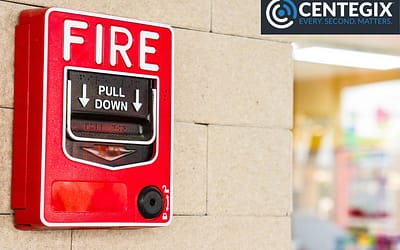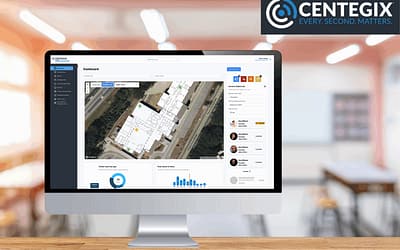Oklahoma’s HB 4073 is a statewide effort to improve emergency response times and strengthen school safety. Oklahoma passed HB 4073, its version of Alyssa’s Law, in June 2024. Alyssa’s Law requires that schools incorporate mobile panic alert systems into their school safety plans. These systems must connect school staff and first responders during emergencies. The law aims to create safe schools by providing staff with a quick, reliable method of requesting help during emergencies. Because seconds matter in a crisis.
Now is the time for Oklahoma districts to understand what Alyssa’s Law requires, how to comply, and why selecting the right solution matters. The Oklahoma State Department of Education has approved CENTEGIX® as a school emergency alert system vendor. The CENTEGIX Safety Platform™ serves as the foundation of a multilayered school safety plan, empowering schools to meet Alyssa’s Law requirements and foster a culture of safety on campus.
What Is Alyssa’s Law and What Does HB 4073 Require?
Alyssa’s Law is named for Alyssa Alhadeff, who was killed in the 2018 Marjory Stoneman Douglas High School shooting in Parkland, FL. Many states have passed their own versions of Alyssa’s Law recently. This critical legislation addresses the issue of law enforcement response time when a life-threatening emergency occurs, because time equals life. Alyssa’s Law requires schools to install silent panic alarms that are directly linked to law enforcement, allowing first responders to arrive at the scene as quickly as possible, eliminate threats, and triage any victims in an emergency.
According to HB 4073’s author, Representative Kevin Wallace, “Alyssa’s Law ties school security together by coordinating our schools and law enforcement. [Even] the most secure buildings have vulnerabilities when communication isn’t clear.”
Oklahoma’s House Bill 4073 requires public schools to implement a school security alert and response system. Each school’s system must:
- Automatically alert designated school personnel when an emergency response is initiated on-site by smartphone application, phone call, text message, or other technology.
- Provide emergency responders with floor plans, caller location, and other critical info during 911 calls.
- Integrate designated school personnel with emergency responders to provide real-time situational updates during emergencies.
How the CENTEGIX Safety Platform Helps You Meet—and Exceed—Alyssa’s Law Requirements
Not all mobile panic alert systems meet the specific criteria in HB 4073. The law requires more than a “panic button;” it specifies that a school alert system must provide automatic location-based alerts, real-time updates, and other critical emergency information and notifications. The CENTEGIX Safety Platform empowers school leaders to meet and exceed these requirements.
Unlike other emergency response systems, many of which are retrofitted from different industries, CENTEGIX CrisisAlert™ was developed from the ground up as a wearable solution. Built on private networks, CrisisAlert includes features such as strobes for emergency notification and provides precise alert location details, empowering schools with an effective and reliable way to improve emergency response times.
HB 4073 requirement #1
School alert systems automatically alert designated school personnel when an emergency response is initiated on-site via a smartphone application, phone call, text message, or other technology.
CrisisAlert:
- Empowers staff to alert school personnel of an emergency using a wearable badge.
- Facilitates discreet alerts; CrisisAlert users simply press a button on their wearable device to initiate the school safety protocols.
- Provides reliable schoolwide coverage; the Safety Platform runs on private LoRaWAN and Bluetooth networks that do not rely on Wi-Fi or cellular service.
- Invites staff to participate in creating safe schools by empowering every staff member to summon help and communicate with law enforcement.
HB 4073 requirement #2
School alert systems provide emergency responders with floor plans, the precise location of the person needing help, and other critical info during 911 calls.
- Safety Platform transmits campus-wide lockdown details to public safety answering points, such as 9-1-1 with the level of the emergency, who initiated the alert and precisely where they are.
- Safety Blueprint™, the mapping and location component of the Safety Platform, features up-to-date digital critical incident maps that provide the real-time location information required by HB 4073.
- Safety Blueprint maps also include a school’s safety asset locations so first responders know what emergency equipment is available and where it is located.
HB 4073 requirement #3
School alert systems must integrate designated school personnel with emergency responders to provide real-time situational updates during emergencies.
- The system can include pre-defined response options to facilitate rapid communication during a crisis. This feature allows the alert initiator to send quick, standardized messages, reducing the time needed to convey critical information and enabling faster decision-making.The Safety Platform Dashboard provides clear, accurate information to designated personnel, thus eliminating information silos and miscommunication when every second matters.
- Strobes and other audiovisual notifications facilitate clear, campus-wide communication during emergencies.
How CrisisAlert Helps Create Safe Schools
The CENTEGIX Safety Platform enables schools to meet the requirements of Alyssa’s Law in Oklahoma. Safety Platform:
- Enables rapid response. Using the CrisisAlert badge, staff can initiate instant alerts that are integrated with law enforcement and first responders to accelerate emergency response.
- Provides reliable connectivity. Thanks to their CrisisAlert badge, staff are not obligated to track down their personal cell phone or remember an app password during a stressful emergency. Dedicated networks guarantee reliable communication.
- Enacts best practices in school safety. Wearable panic buttons are consistent with federal-level recommendations for creating safe schools and are widely considered essential elements of effective school safety plans.
- Provides responders with accurate, detailed, location-specific information in real time on Safety Blueprint critical incident maps.
- Eliminates communication hand-offs and errors by providing all responders with accessible, accurate information on the Safety Platform Dashboard and via direct integration with first responders and law enforcement.
- Facilitates the creation of effective school safety plans and seamless dissemination of updates and information.
Oklahoma’s passage of HB 4073 marks a critical step forward in school safety. As schools work to meet the requirements of Alyssa’s Law, deciding which system to implement is about more than compliance—it’s about protecting lives. CENTEGIX offers a trusted, comprehensive solution that meets the letter of the law and empowers schools to respond to emergencies rapidly.
Schedule a demo today to learn more about how the CENTEGIX Safety Platform can help your district create safe schools by meeting—and exceeding—Alyssa’s Law requirements.












